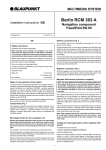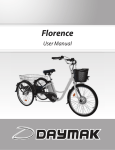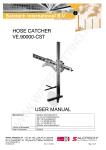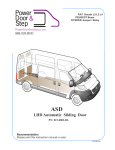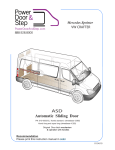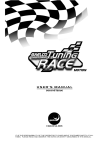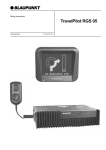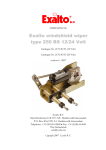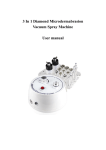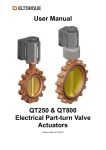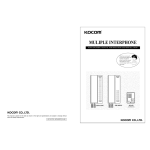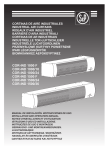Download HOSE CATCHER VE.70000
Transcript
HOSE CATCHER VE.70000 USER MANUAL Contents 1. Use and Safety........................................................................................... 3 2. Safety directions:........................................................................................ 5 3. Exploded view ............................................................................................ 6 4. List of parts................................................................................................. 7 5. Assembly and use ...................................................................................... 9 5.1 General procedure for use of Hose Catcher ..................................... 11 Notes .................................................................. Error! Bookmark not defined. Rev. 05-2007 Salotech International B.V. © Hose Catcher VE.70000 Page 2 of 11 1. Use and Safety The Hose Catcher (Deflector) is a specially constructed adjustable auxiliary tool for cleaning pipe bundles by means of a hose with a cleaning nozzle fixed to the front. All the pipes in the bundle can be reached because of the construction with two hinged points. The advantage of the modular construction of the hose catcher is that an adaptor can be fixed to a foot pedal so that a vertical heat exchanger can be cleaned. Besides this the hose catcher can be used for one single pipe after removal of the hinged arm. The Hose Catcher can be fixed to a pipe or heat exchanger in various ways. This will be explained further in Chapter 5. Cleaning hoses of different diameters can be used due to the various diameters of the interchangeable stoppers. The hose catcher can be adjusted by the hand grips for hoses of various weights, so that the strength necessary to adjust the Hose Catcher remains the same. A round (Lexan) plate has been fixed on to protect the operator from backsplash water. Working with high pressure is not without risk. You must read and follow the instructions explained in this user manual accurately to work safely. Always follow the prescribed (safety) procedures before starting high pressure work. We wish to point out that our products may only be used if the operating personnel are wearing the correct personal safety equipment. Furthermore it is strictly recommended that the operator is familiar with the directions laid down by the Stichting Industriële Reiniging (SIR) [Industrial Cleaning Foundation] and the Labour Inspectorate, and is also in possession of a certificate ‘High Pressure Operator’ and/or has sufficient experience with high pressure apparatus. Rev. 05-2007 Salotech International B.V. © Hose Catcher VE.70000 Page 3 of 11 We advise that only (cleaning) hoses with a marking ring at a distance of 50 mm behind the pressure cover are used. If a hose without a marking ring is used the hose will be caught by the pressure cover. This pressure cover is therefore not suitable. Always select a stopper that corresponds to the hose: the marking ring must not be able to pass through the opening in the stopper. A short lead lance (150 mm) can be used to ease the insertion of the cleaning hose into the pipe. Make sure that the location of the First Aid post is known so that medical help can be called in immediately if there is an accident. Rev. 05-2007 Salotech International B.V. © Hose Catcher VE.70000 Page 4 of 11 2. Safety directions: • Make sure that the workplace is clean and always fence off an area of at least 6 meters around the spaying area, with tape and warning signs for example. • All personnel in the direct vicinity of the workplace must wear the prescribed protective equipment (earplugs, full face mask, protective boots, protective gloves, etc). • Check whether there is any external damage and if all control functions are working properly before use. Make sure all the connections are tightly screwed up and free of leaks. Use well fitting tools for this. • Check that the cleaning nozzle is not blocked; clean if necessary or replace. • Rinse the hose through before fixing the cleaning nozzle. • Always fix the splashboard on the hinged arm. • At the start of work increase the pump gently from the stationary to the working pressure checking, at the same time, whether the connections are still free of leaks. • Never exceed the maximum permitted working pressure. • The person operating the cleaning hoses also operates the (dump-style) foot pedal! Rev. 05-2007 Salotech International B.V. © Hose Catcher VE.70000 Page 5 of 11 3. Exploded view Rev. 05-2007 Salotech International B.V. © Hose Catcher VE.70000 Page 6 of 11 4. List of parts No. 1 2 3 4 5 6 7 8 9 10 11 12 13 14 15 16 17 18 19 20 21 22 23 24 25 26A 26B Description Assembly plate Hinged arm left Hinged arm right Cover Hinge pin left Hinge pin right Axial slide bearing Cupped spring washer Washer M16 Handle Locking pin + clip Bolt M10 - 50 Washer M10 Locking nut M10 Wing screw M6- 15 Bolt M6 – 50 Washer M6 Locking nut M6 Adapter Guide bush Hose connection Pipe nipple Protection plate Hand grip Retaining ring Stopper 8.5mm Stopper 10.5mm Number 1 1 1 1 1 1 6 6 2 2 1 1 2 1 1 1 2 1 1 1 1 1 1 1 2 1 1 26C Stopper 12.5mm 1 26D 26E 27 28 1 1 1 2 Stopper 14mm Stopper 28mm Bolt M8 - 45 Washer M8 Rev. 05-2007 Salotech International B.V. © Hose Catcher VE.70000 Art. No. SL.07-011 SL.07-021 SL.07-031 SL.07-032 SL.07-042 SL.07-043 SL.07-051 SL.07-080 DIN 125 –M16 NLM06440-216 SL.07-090 DIN 933.M10x50 DIN125.M10 DIN985.M10 DIN316.M6x15 DIN316.M06x50 DIN125.M6 DIN985.M06 SL.07-062 SL.07-011-2 FW.6670162 NDX-S23-1 1/4” SL.07.062 SL.07-061 A-050 RV8-28-108-8.5 RV8-28-10810.5 RV8-28-10812.5 RV8-28-108-14 RV8-28-108-28 DIN933.M8x45 DIN125.M8 Page 7 of 11 29 Nut M8 Rev. 05-2007 1 Salotech International B.V. © Hose Catcher VE.70000 DIN934.M8.A2 Page 8 of 11 5. Assembly and use It is recommended that work with high pressure apparatus is carried out in accordance with the regulations of the SIR. These can be found in the SIR handbook. We want to point out once again that only trained personnel may work with the high pressure apparatus. 1. Determine the best cleaning method and assembly option on the basis of the situation. 2. Use of hose catcher for a horizontal heat exchanger a. Determine the best assembly option. The use of the assembly plate directly up against the flange of the heat exchanger is always preferable. i. Assembly plate directly up against the heat exchanger. Fix the assembly plate directly up against the heat exchanger. Make sure that the correct diameter bolts and washers are used so that they cannot pass through the bolt holes. ii. Assembly with clamps. Fix the assembly plate and clamp on the edge of a heat exchanger. Tighten both bolts to 30Nm. b. Follow the general procedure described in Chapter 5.1 further. 3. Use of hose catcher for a vertical heat exchanger a. Dismantle the adapter by removing bolt (12-14). b. Fix the attachment on the foot pedal, determine on which side you want to work with the hose catcher. The attachment can be fixed to the foot pedal on both sides. c. Fix the adapter on the attachment. d. Follow the general procedure described in Chapter 5.1 further. Rev. 05-2007 Salotech International B.V. © Hose Catcher VE.70000 Page 9 of 11 4. Use of hose catcher for a pipe. a. Dismantle the hinge arm by removing locking pin 11. Fixing the locking pin in the shaft is recommended to prevent the loss of the cupped spring washer and the axial slide bearings. b. Fix the assembly plate to the pipe, with clamps if necessary. i. Assembly plate directly up against the heat exchanger. Fix the assembly plate directly up against the heat exchanger. Make sure that the correct diameter bolts and washers are used so that they cannot pass through the bolt holes. ii. Assembly with clamps. Fix the assembly plate and clamp on the edge of a heat exchanger. Tighten both bolts to 30Nm. Selection table Stopper: Internal diameter of stopper Hose to be used 8.5mm 4/2 10.5mm 5/2 12.5mm 6/2 14mm 8/2 28mm 1/2” – NW 13 Rev. 05-2007 Salotech International B.V. © Hose Catcher VE.70000 Page 10 of 11 5.1 General procedure for use of Hose Catcher 1. Select the correct stopper (26 A-E) for the diameter of the cleaning hose used (see selection table page 10). Make sure that the marking ring cannot pass through the opening in the stopper. If this is the case a smaller stopper must be chosen. 2. Loosen the hand grip (24) and feed the cleaning hose through it. Place the stopper with the correct diameter over the hose, behind the marking ring if present and slide into hand grip. Tighten the hand grip again. 3. Slide the cleaning hose into the first pipe. 4. Now adjust the Hose Catcher with both handles (10) so that it remains in the desired stand, without sagging under the weight of the cleaning hose. 5. Fix a hose to the hose connection (21) to remove the returning water. 6. Push the foot pedal in so that the high pressure water can flow. Guide the cleaning hose by hand. 7. When the hose reaches the end of the pipe: stop the flow by removing foot from the foot pedal. The cleaning hose is now pressureless. Pull the cleaning hose back and put the Hose Catcher in front of the next pipe. 8. Repeat steps 8 and 9. In this way the whole pipe bundle can be cleaned. 9. When the whole pipe bundle has been cleaned: clean everything and store tidily. Do you still have questions or comments? Do not hesitate to contact us. You could also look at our website www.salotech.nl, or at www.sir-safe.nl for information about the SIR. Rev. 05-2007 Salotech International B.V. © Hose Catcher VE.70000 Page 11 of 11












